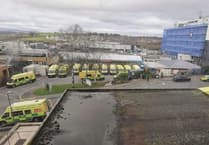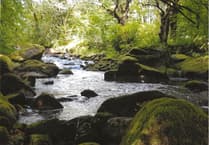The film ’Dunkirk’ raised £730 in voluntary donations for the Ricky Grant Cancer Day Unit at Torbay Hospital.
The former RNLI lifeboat, the Henry Finlay, had a bit part, alongside more famous stars such as Kenneth Branagh and Tom Hardy, in a recent showing of the “Dunkirk’ at Dartmouth’s Flavel centre. The Henry Finlay, a pulling and sailing lifeboat built in 1911, had been on the Dart for a number of years, first in the stewardship of Peter Lucas and latterly, in that of Alister Harbord.
During Alister’s ownership she became a familiar sight both moored off the North Embankment and running trips on the river.
In 2016, Alister sold her to Warner Brothers who were buying period boats to take part in Christopher Nolan’s then, upcoming, film about the Dunkirk evacuations. A year later, the film was released to much critical acclaim.
Alister takes up the story: “A friend of ours, Alex Lewis, is part of Warner Brothers in the United Kingdom and has been on the boat. I was stunned when she told me that she had arranged for a private showing at the Flavel of the film for my family, friends and colleagues. In the end about eighty people, including a number of staff from Torbay Hospital, came to the showing.
“A great cheer went up when the Henry Finlay appeared on screen leading the first reveal of the Little Ships as they approached Dunkirk beach and then she kept popping up in various guises throughout the film.
“I really enjoyed my time with the Henry Finlay and it was with great regret that I had to part with the old girl. I remember playing as a child in the ruins of her first station at Machrihanish on the tip of the Mull of Kintyre . My Mother’s family had a base on the Isle of Arran and I spent many a happy time there.
“When I first came across her, I was struck by the thought that I must be one of the few people in Dartmouth who had a connection with her old home and who had visited it. It was almost as if she had found me.
“Dunkirk is an amazing film and I am very grateful to Alex, Warner Brothers and the team from the Flavel for arranging the showing free of charge. We decided to take the opportunity to raise funds for the Ricky Grant Day Unit through a voluntary bucket collection and were stunned at the amount that folks dropped into the yellow buckets on their way out after watching the film.”
Ruth Allison, Senior Sister and Unit Manager of Ricky Grant Day Unit said: “We are very grateful to Alister and his friends for the fundraising they have undertaken for Ricky Grant Day Unit over the past few years and especially for this latest fundraising endeavour which has proved a great success.
“Our staff work really hard to provide the special care and attention that our patients deserve. It is thanks to such kind and generous support, that we are able to add those extra little touches that make the unit’s environment more comfortable.”
The ’Henry Finlay’, a thirty-five foot, self-righting sailing and rowing lifeboat was built for the R.N.L.I. at the Thames Ironworks and Shipbuilding Company yard on the Thames at Blackwall in 1911 with the official number 618.
In 1912, she was sent to the newly created Lifeboat Station at Machrihanish on the south-western end of Scotland’s Mull of Kintyre. The new station was opened following the loss of a trawler, which had been driven ashore at Westport, four miles north of Machrihanish, during a blizzard in 1908.
On that occasion, rescue attempts from Campbeltown were to no avail as the roads were blocked by snowdrifts. The ’Henry Finlay’ was at Machrihanish until the station was closed in 1931 it being felt at that time that the ’City of Glasgow’, the new motorized lifeboat at Campbelton could cover the area.
The ’Henry Finlay’ was the first and the last lifeboat to be stationed there: In the 18 years that the station was open there was never a launch to casualty.The ’Henry Finlay’ was towed to Ardrossan by the ’City of Glasgow’ and was transported by rail to her new station at Teignmouth in Devon where she stayed until sold out of the service in 1945 and is credited with saving two lives.
On leaving the RNLI she became a trip boat ‘
The Teignmouth Belle’ and latterly the ‘Henrietta’ in the Shaldon area. In 2008, the ’Henrietta’ was purchased by lifeboat enthusiast Peter Lucas who commenced an extensive programme of repairs and renovations which Alister completed on purchasing her form Peter. Finally, in 2012, she was re-launched and became once more the Henry Finlay.




